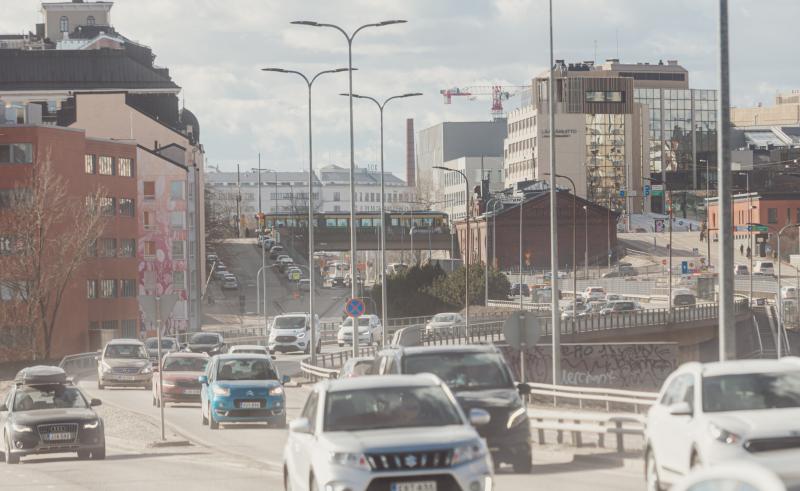Noise abatement
Noise remains a notable environmental issue, even in Helsinki. Environmental noise decreases the quality and comfort of the living environment, and continuous loud noise may also cause health hazards. Road traffic is the primary source of harmful noise in Helsinki. 37% of the residents of Helsinki live in areas where the noise level caused by road traffic exceeds the limit value of 55 dB during the day. Noise is locally also caused by construction and repair work, public events and restaurants, for example.
The City’s traffic noise situation is being monitored according to the Environmental Noise Directive through a noise survey carried out every five years. The preparation for a new noise survey started in 2021 and will be completed in summer 2022. Based on the noise survey, a new noise abatement action plan will be prepared to steer the City’s noise abatement work. The current action plan for 2018–2022 contains measures related to city planning, affecting the noise source, and structural noise abatement, among other things.

Several actions to improve the soundscape
Harmful noise is also prevented through land use and transport planning. Transport investments and land use are always planned together in Helsinki, which also makes it possible to pay attention to noise abatement. New residential areas or other noise-sensitive functions will not be placed in areas exposed to noise without sufficient noise abatement. The noise hazards from various facilities and temporary functions are regulated by the Environmental Protection Act and the environmental protection regulations of the City of Helsinki.
By improving the prerequisites of public transport, pedestrian traffic and cycling, the aim has been to steer traffic towards more sustainable forms of transport. For example, the redevelopment of Hämeentie that was completed in 2021 will improve the safety of pedestrians and cyclists and make public transport smoother. The construction of Kaisantunneli that started in 2021 will also improve pedestrian and cycling traffic to the east and west, for its part. The promotion of sustainable and also lower-noise transport is covered in more detail in the section titled Transport.
Vehicles becoming increasingly electric will also affect the soundscape in the city somewhat. Helsinki’s goal is for electric cars to account for 30% of the vehicle population of Helsinki in 2030. In 2021, the number of electric cars grew significantly from the previous year. The goal of Helsinki Region Transport (HSL) is for at least 30% of HSL’s buses (approximately 400 units) to run on electricity by 2025. By the end of 2021, there were 176 electric buses, 80 of which operated in the Helsinki area.
The City of Helsinki annually allocates funds for noise barriers on streets. In 2021, about 0.3 million euros were allocated to the planning of a noise barrier on Vanha Porvoontie. Highway noise abatement is primarily the responsibility of the Uusimaa Centre for Economic Development, Transport and the Environment and the Finnish Transport Infrastructure Agency. On Konalantie and Topeliuksenkatu, streets were re-paved with noise-reducing materials. The City also started a campaign to promote the use of studless winter tyres.
Only a few events
In terms of noise from events, 2021 was quieter than normally since large outdoor concerts were cancelled for the second year in a row. However, construction projects continued in the city as usual. Intensive residential construction continued in Jätkäsaari, Pasila, Kruunuvuorenranta and Kuninkaantammi, among other districts.
The Route Eight Roadworks, that is, the redevelopment of Caloniuksenkatu, Runeberginkatu and Helsinginkatu streets, began in January 2021 and will continue until 2023. The construction of Kaisantunneli, which involves some noise abatement challenges, began and will continue until autumn 2023. The work on the Crown Bridges tramway started in Hakaniemi, Sompasaari, Korkeasaari and Kruunuvuorenranta in the autumn. The construction of the new tramway will continue until 2027. The special challenge related to noise abatement in this worksite involves protecting the zoo from noise.
It was possible to reduce temporary noise hazards through efficient communication and by agreeing on noise abatement with especially sensitive sites in advance.
Eyes on the future
As the city becomes denser, it is also important for attention to be paid to the soundscape and noise abatement in the future.
Even though 2021 was quiet in terms of events and outdoor concerts, in autumn 2021, the Environmental Services still prepared for events to be held in 2022 by preparing a new timing policy for outdoor concerts. After the pandemic, more concerts can be organised at the key event venues in 2022 when compared to past years. Compared to previous levels, the number of outdoor concerts increased in the Olympic Station and the former Malmi Airport, in addition to which the third day of an event must end by 23.00.
